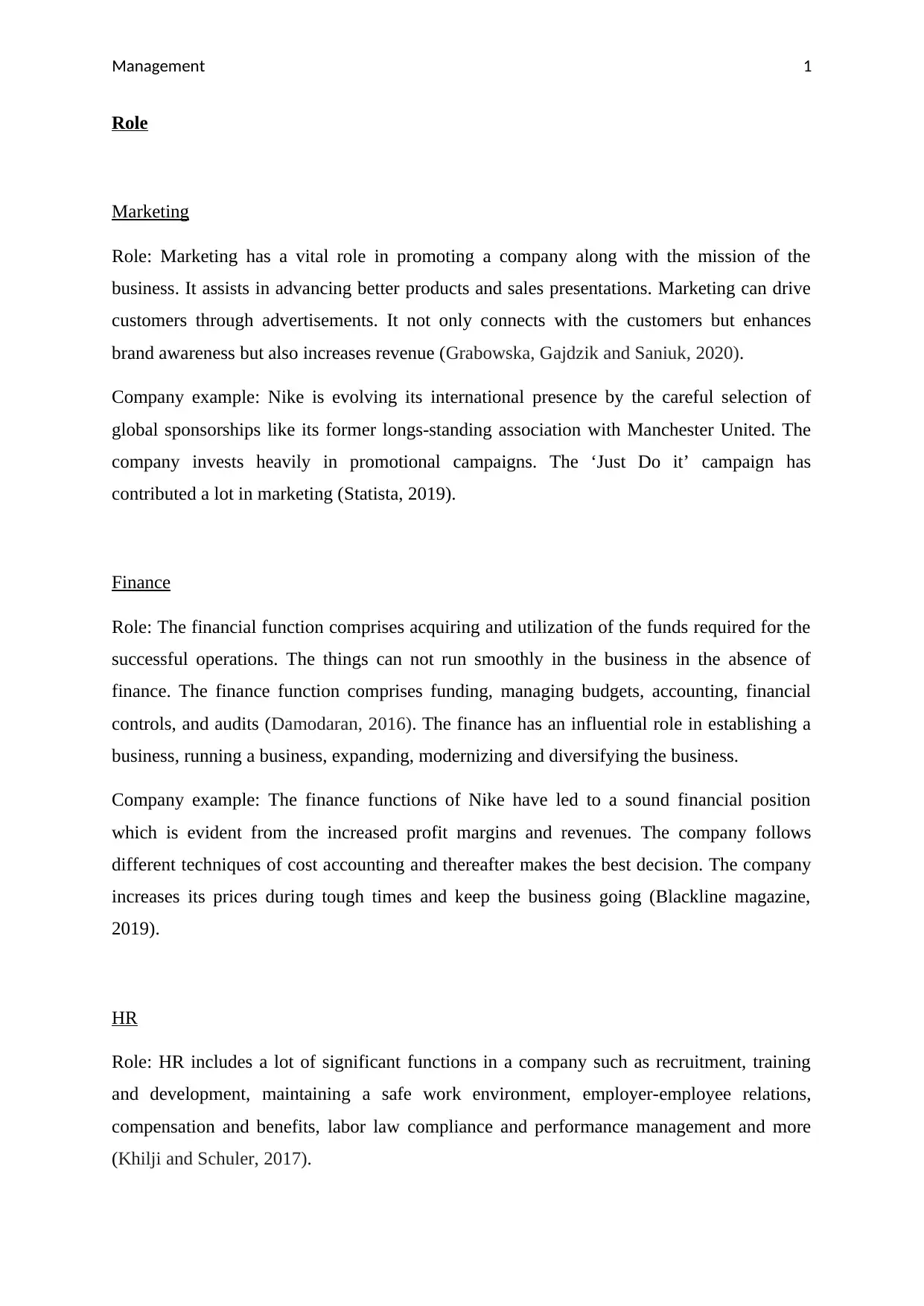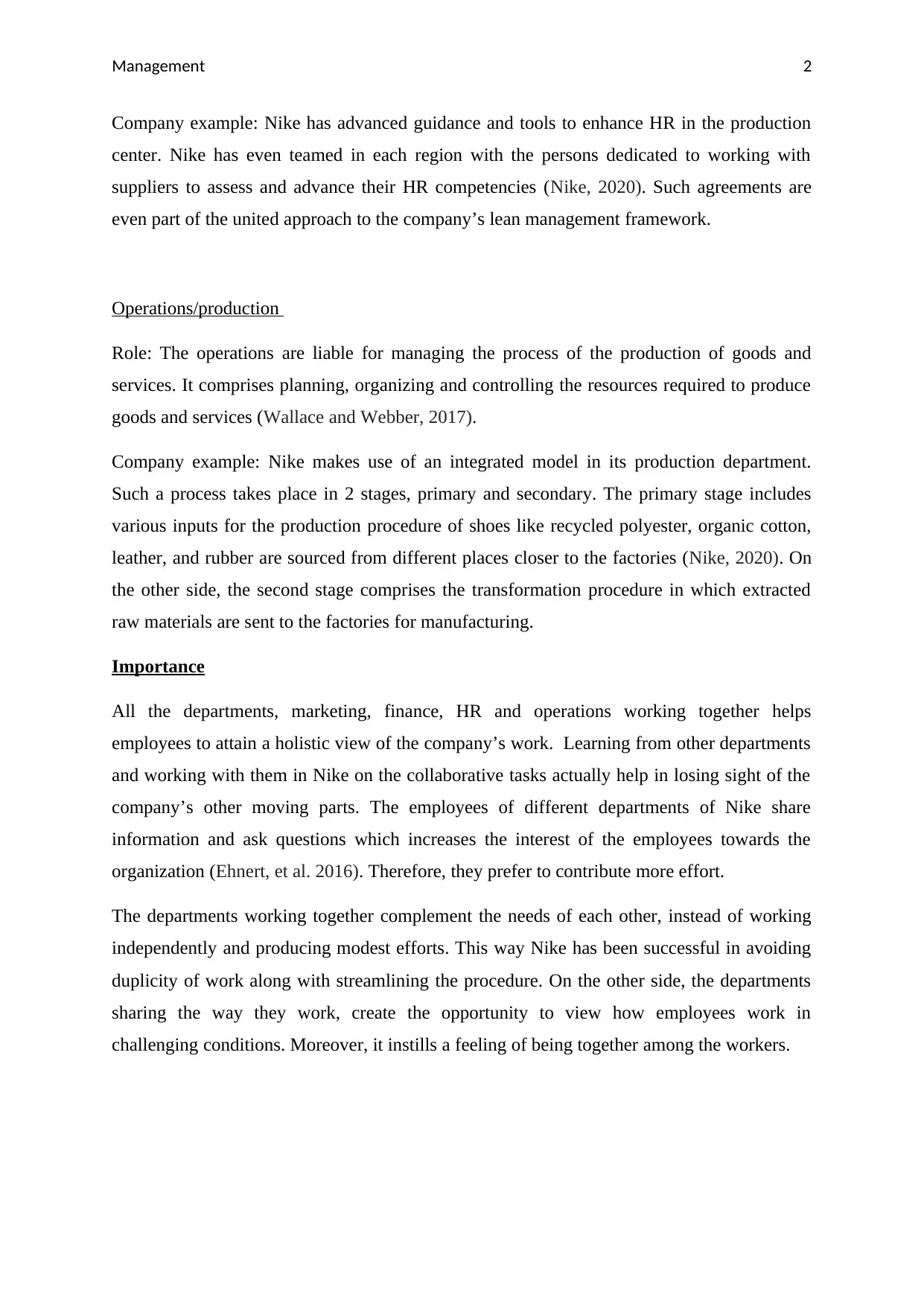Business Functions: Roles and Importance Report (MG408)
VerifiedAdded on 2022/08/13
|4
|954
|29
Report
AI Summary
This report, prepared for the MG408 Graduate Challenge module, explores the roles of marketing, finance, human resources (HR), and operations/production within a business context. It defines each function, highlighting its key responsibilities and contributions to overall business success. The report emphasizes the importance of these departments working collaboratively, drawing upon academic texts and real-world examples, such as the case of Nike. It demonstrates how effective integration of these functions leads to a holistic view of the company's work, avoids duplication, and streamlines processes. The analysis underscores the benefits of shared information and collaborative efforts in achieving organizational goals, with relevant references supporting the points made.

Management
Paraphrase This Document
Need a fresh take? Get an instant paraphrase of this document with our AI Paraphraser

Management 1
Role
Marketing
Role: Marketing has a vital role in promoting a company along with the mission of the
business. It assists in advancing better products and sales presentations. Marketing can drive
customers through advertisements. It not only connects with the customers but enhances
brand awareness but also increases revenue (Grabowska, Gajdzik and Saniuk, 2020).
Company example: Nike is evolving its international presence by the careful selection of
global sponsorships like its former longs-standing association with Manchester United. The
company invests heavily in promotional campaigns. The ‘Just Do it’ campaign has
contributed a lot in marketing (Statista, 2019).
Finance
Role: The financial function comprises acquiring and utilization of the funds required for the
successful operations. The things can not run smoothly in the business in the absence of
finance. The finance function comprises funding, managing budgets, accounting, financial
controls, and audits (Damodaran, 2016). The finance has an influential role in establishing a
business, running a business, expanding, modernizing and diversifying the business.
Company example: The finance functions of Nike have led to a sound financial position
which is evident from the increased profit margins and revenues. The company follows
different techniques of cost accounting and thereafter makes the best decision. The company
increases its prices during tough times and keep the business going (Blackline magazine,
2019).
HR
Role: HR includes a lot of significant functions in a company such as recruitment, training
and development, maintaining a safe work environment, employer-employee relations,
compensation and benefits, labor law compliance and performance management and more
(Khilji and Schuler, 2017).
Role
Marketing
Role: Marketing has a vital role in promoting a company along with the mission of the
business. It assists in advancing better products and sales presentations. Marketing can drive
customers through advertisements. It not only connects with the customers but enhances
brand awareness but also increases revenue (Grabowska, Gajdzik and Saniuk, 2020).
Company example: Nike is evolving its international presence by the careful selection of
global sponsorships like its former longs-standing association with Manchester United. The
company invests heavily in promotional campaigns. The ‘Just Do it’ campaign has
contributed a lot in marketing (Statista, 2019).
Finance
Role: The financial function comprises acquiring and utilization of the funds required for the
successful operations. The things can not run smoothly in the business in the absence of
finance. The finance function comprises funding, managing budgets, accounting, financial
controls, and audits (Damodaran, 2016). The finance has an influential role in establishing a
business, running a business, expanding, modernizing and diversifying the business.
Company example: The finance functions of Nike have led to a sound financial position
which is evident from the increased profit margins and revenues. The company follows
different techniques of cost accounting and thereafter makes the best decision. The company
increases its prices during tough times and keep the business going (Blackline magazine,
2019).
HR
Role: HR includes a lot of significant functions in a company such as recruitment, training
and development, maintaining a safe work environment, employer-employee relations,
compensation and benefits, labor law compliance and performance management and more
(Khilji and Schuler, 2017).

Management 2
Company example: Nike has advanced guidance and tools to enhance HR in the production
center. Nike has even teamed in each region with the persons dedicated to working with
suppliers to assess and advance their HR competencies (Nike, 2020). Such agreements are
even part of the united approach to the company’s lean management framework.
Operations/production
Role: The operations are liable for managing the process of the production of goods and
services. It comprises planning, organizing and controlling the resources required to produce
goods and services (Wallace and Webber, 2017).
Company example: Nike makes use of an integrated model in its production department.
Such a process takes place in 2 stages, primary and secondary. The primary stage includes
various inputs for the production procedure of shoes like recycled polyester, organic cotton,
leather, and rubber are sourced from different places closer to the factories (Nike, 2020). On
the other side, the second stage comprises the transformation procedure in which extracted
raw materials are sent to the factories for manufacturing.
Importance
All the departments, marketing, finance, HR and operations working together helps
employees to attain a holistic view of the company’s work. Learning from other departments
and working with them in Nike on the collaborative tasks actually help in losing sight of the
company’s other moving parts. The employees of different departments of Nike share
information and ask questions which increases the interest of the employees towards the
organization (Ehnert, et al. 2016). Therefore, they prefer to contribute more effort.
The departments working together complement the needs of each other, instead of working
independently and producing modest efforts. This way Nike has been successful in avoiding
duplicity of work along with streamlining the procedure. On the other side, the departments
sharing the way they work, create the opportunity to view how employees work in
challenging conditions. Moreover, it instills a feeling of being together among the workers.
Company example: Nike has advanced guidance and tools to enhance HR in the production
center. Nike has even teamed in each region with the persons dedicated to working with
suppliers to assess and advance their HR competencies (Nike, 2020). Such agreements are
even part of the united approach to the company’s lean management framework.
Operations/production
Role: The operations are liable for managing the process of the production of goods and
services. It comprises planning, organizing and controlling the resources required to produce
goods and services (Wallace and Webber, 2017).
Company example: Nike makes use of an integrated model in its production department.
Such a process takes place in 2 stages, primary and secondary. The primary stage includes
various inputs for the production procedure of shoes like recycled polyester, organic cotton,
leather, and rubber are sourced from different places closer to the factories (Nike, 2020). On
the other side, the second stage comprises the transformation procedure in which extracted
raw materials are sent to the factories for manufacturing.
Importance
All the departments, marketing, finance, HR and operations working together helps
employees to attain a holistic view of the company’s work. Learning from other departments
and working with them in Nike on the collaborative tasks actually help in losing sight of the
company’s other moving parts. The employees of different departments of Nike share
information and ask questions which increases the interest of the employees towards the
organization (Ehnert, et al. 2016). Therefore, they prefer to contribute more effort.
The departments working together complement the needs of each other, instead of working
independently and producing modest efforts. This way Nike has been successful in avoiding
duplicity of work along with streamlining the procedure. On the other side, the departments
sharing the way they work, create the opportunity to view how employees work in
challenging conditions. Moreover, it instills a feeling of being together among the workers.
⊘ This is a preview!⊘
Do you want full access?
Subscribe today to unlock all pages.

Trusted by 1+ million students worldwide

Management 3
References
Blackline magazine, 2019. How Nike is transforming financial close process with Blackline.
Available from https://www.blackline.com/blog/financial-close/nike-transforming-financial-
close-processes/ [Accessed on 02/03/2020]
Damodaran, A., 2016. Damodaran on valuation: security analysis for investment and
corporate finance (Vol. 324). John Wiley & Sons.
Ehnert, I., Parsa, S., Roper, I., Wagner, M. and Muller-Camen, M., 2016. Reporting on
sustainability and HRM: A comparative study of sustainability reporting practices by the
world's largest companies. The International Journal of Human Resource
Management, 27(1), pp.88-108.
Grabowska, S., Gajdzik, B. and Saniuk, S., 2020. The Role and Impact of Industry 4.0 on
Business Models. In Sustainable Logistics and Production in Industry 4.0 (pp. 31-49).
Springer, Cham.
Khilji, S.E. and Schuler, R.S., 2017. Talent management in the global context. The Oxford
handbook of talent management, p.399.
Nike, 2020. Governance. Available from https://purpose.nike.com/sustainability-governance
[Accessed on 02/03/2020]
Nike, 2020. Strengthening human resource management. Available from
https://purpose.nike.com/human-resources-management [Accessed on 02/03/2020]
Statista, 2019. Nike’s advertising spending in the United States from 2009 to 2018. Available
from https://www.statista.com/statistics/463063/nike-ad-spend-usa/ [Accessed on
02/03/2020]
Wallace, M. and Webber, L., 2017. The disaster recovery handbook: A step-by-step plan to
ensure business continuity and protect vital operations, facilities, and assets. Amacom.
References
Blackline magazine, 2019. How Nike is transforming financial close process with Blackline.
Available from https://www.blackline.com/blog/financial-close/nike-transforming-financial-
close-processes/ [Accessed on 02/03/2020]
Damodaran, A., 2016. Damodaran on valuation: security analysis for investment and
corporate finance (Vol. 324). John Wiley & Sons.
Ehnert, I., Parsa, S., Roper, I., Wagner, M. and Muller-Camen, M., 2016. Reporting on
sustainability and HRM: A comparative study of sustainability reporting practices by the
world's largest companies. The International Journal of Human Resource
Management, 27(1), pp.88-108.
Grabowska, S., Gajdzik, B. and Saniuk, S., 2020. The Role and Impact of Industry 4.0 on
Business Models. In Sustainable Logistics and Production in Industry 4.0 (pp. 31-49).
Springer, Cham.
Khilji, S.E. and Schuler, R.S., 2017. Talent management in the global context. The Oxford
handbook of talent management, p.399.
Nike, 2020. Governance. Available from https://purpose.nike.com/sustainability-governance
[Accessed on 02/03/2020]
Nike, 2020. Strengthening human resource management. Available from
https://purpose.nike.com/human-resources-management [Accessed on 02/03/2020]
Statista, 2019. Nike’s advertising spending in the United States from 2009 to 2018. Available
from https://www.statista.com/statistics/463063/nike-ad-spend-usa/ [Accessed on
02/03/2020]
Wallace, M. and Webber, L., 2017. The disaster recovery handbook: A step-by-step plan to
ensure business continuity and protect vital operations, facilities, and assets. Amacom.
1 out of 4
Related Documents
Your All-in-One AI-Powered Toolkit for Academic Success.
+13062052269
info@desklib.com
Available 24*7 on WhatsApp / Email
![[object Object]](/_next/static/media/star-bottom.7253800d.svg)
Unlock your academic potential
Copyright © 2020–2025 A2Z Services. All Rights Reserved. Developed and managed by ZUCOL.




